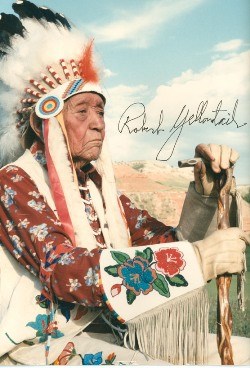
NPS The Path To Leadership At age 13, Yellowtail, who was known for both his intelligence and stubbornness was sent to Sherman Institute in Riverside, California where he excelled, graduating in 1907. He became interested in Indian law and wanted to help his people, which lead him to spend time at the Extension Law School in Los Angeles. He would gain a law degree via correspondence courses from the prestigious University of Chicago. Yellowtail had decided to make defending the Crow tribe his mission. Saving The Reservation In this battle, Yellowtail’s stubbornness came in quite handy. Over seven long years Yellowtail countered Walsh’s ferocious attacks. Finally in 1917, Yellowtail and the Crow were victorious as the reservation lands were kept under tribal control. In the following years, Yellowtail’s accomplishments were unprecedented in U.S. history.
Fighting For The Bighorn The pressure mounted on Yellowtail and cracks in tribal unity began to materialize. Government agents spread rumors that Yellowtail was willing to sell out the tribe for his own interests. Nothing could have been further from the truth. The government had offered $1.5 million dollars for 7,000 acres needed for construction of the dam. The tribe had valued it at $5 million dollars. Yellowtail. When forced to negotiate by the government’s take it or leave it policy, Yellowtail played hardball. He said the dam’s construction would be allowed if the government paid $1 million a year for 50 years to lease the land. When the 50 years expired the Crow would get the dam and the land. Complicated politicking ensued. In the end, the government got everything - the dam, land, and all future proceeds - for only $5 million dollars. This meant only $600 dollars for each tribal member. A harsh irony took place when the dam was named in Yellowtail‘s honor. Yellowtail was heartbroken, this was a battle he could not win. Yet Yellowtail never gave up. In the 1970’s he fought for Crow mineral rights on their reservation land. Twenty percent of all the coal in the western United States was under Crow land. The Bureau of Indian Affairs was attempting to sell off the rights to private interests for a vastly undervalued sum. The tribe united once again under Yellowtail’s leadership. This time the Crow’s were victorious. The Ultimate Battle In June of 1988, Robert Yellowtail died. He was 98. The Crow people mourned the loss of a man who had led them through some of their most difficult moments. The reservation remained intact, the Crow’s now governed themselves, they had their mineral rights. All of this was due to Yellowtail’s untiring efforts. Yellowtail’s legacy would be that of a warrior, who fought and won the ultimate battle for his people - personal, tribal, and economic freedom. |
Last updated: May 31, 2022
